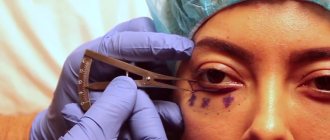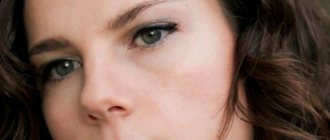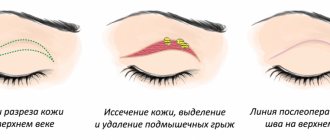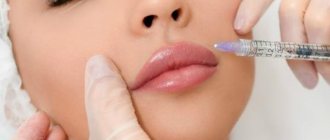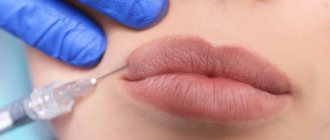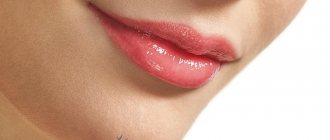Non-surgical blepharoplasty is a cosmetic procedure that restores skin elasticity without surgery. The difficulty of correction in this area is that the skin of the eyelids is very thin and quickly becomes wrinkled. You can eliminate age-related changes and restore the elasticity of the skin with the help of injection therapy, which is an alternative to traumatic plastic surgery. Therefore, older women are advised to know what blepharoplasty is and why it is needed.
Objectives
Non-surgical blepharoplasty is aimed at restoring the physiological elasticity of the eyelids and improving their appearance. The procedure will achieve the following effects:
- fill and smooth out wrinkles under the eyes;
- eliminate excess skin, for example, with an overhanging eyelid;
- adjust the shape of the eye;
- improve the condition of local tissues - connective tissue and muscles;
- fill bags under the eyes, remove excess fat deposits and hernias;
- restore normal skin metabolism, increase its nutrition and hydration;
- correct eyelid asymmetry.
Eyelid surgery significantly refreshes the face and improves its appearance. The procedure allows you to actively fight the aging process. The age at which blepharoplasty is necessary depends on the individual characteristics of the skin. When the first age-related changes appear, it is worth
Surgical eyelid correction
Blepharoplasty with surgery is an effective way to correct significant age-related eyelid defects. Usually performed under general anesthesia. The upper eyelid is cut with a scalpel in the area of the natural fold, the lower eyelid is cut along the moist, inner surface. The surgeon will then remove excess fat and skin and close the incisions.
The operation lasts on average from one to three hours. After blepharoplasty, the rehabilitation period begins. The stitches are removed after a day, but swelling and bruising remain on the face for about one to two weeks. Moreover, during the recovery period you should not use cosmetics: it can interfere with healing. The patient returns to normal life without restrictions within a couple of weeks after blepharoplasty. Swelling disappears without a trace, but surgical scars, although very thin, are still noticeable upon close inspection, so they have to be hidden under makeup.
Types of blepharoplasty
The plastic method includes a wide range of types, among which injection and hardware methods can be distinguished. Each type of non-surgical blepharoplasty has its pros and cons.
Injection therapy
Injection blepharoplasty involves the injection of medications into the eyelid area. The products increase the elasticity of the skin, restore the healthy appearance of the skin and actively eliminate local age-related changes. Most often, preparations are made based on hyaluronic acid, which is a natural component of the skin.
Non-surgical upper eyelid blepharoplasty is divided into two types depending on the goals of the procedure:
- Blepharoplasty of the first type involves straightening the contour of the eyelids and “filling in” wrinkles using lifting techniques. These include procedures such as biorevolutometry, biorevitalization, and hyaluronic therapy. The most promising drugs of this type are HAfiller, Teosyal, Stylage.
- The second type of blepharoplasty is aimed at eliminating swelling and fatty formations in the eyes and eyelids. For this purpose, lipolytic drugs are used to resolve pathological objects and restore the elasticity of the skin under the eyes. In addition, preparations of this type contain a large amount of enzymes and vitamins necessary for tissues.
The choice of treatment method is determined by a cosmetologist based on an assessment of the quality of the skin under the eyes. Based on the examination, the surgeon will determine the necessary direction of work with the patient and select the optimal preparations for cosmetic blepharoplasty.
In addition to the classic injection procedure, the plasma eyelid surgery method is now being actively introduced. It involves the introduction of cold human plasma, previously selected from a vein and processed in a special way. Plasma has a pronounced restorative effect, due to which the lower and upper edges of the eye are smoothed out in patients, thereby ensuring normal skin elasticity.
Due to the fact that plasma is of natural origin, complications are practically impossible during the procedure. The effectiveness and safety of the technique allows it to be widely used to eliminate age-related changes on the eyelids.
Laser blepharoplasty
Laser treatment of the eyelids is one of the most effective methods of lifting this area. Thanks to the ability to fine-tune the laser beam, it is possible to achieve a targeted effect on those layers of skin that need to be removed. A competent choice of intensity of influence ensures complete safety of the procedure for healthy tissues.
Non-surgical plastic surgery involves removing fatty deposits from the eyelids using a carbon dioxide laser, which penetrates deep into the skin and removes excess tissue from the area. During the procedure, you can also remove excess skin, for example, from the surface of the overhanging eyelid. This intervention allows you to restore the normal appearance of the skin without plastic surgery.
Laser therapy has many advantages compared to classical surgery. During surgical plastic surgery, noticeable stitches remain, which then have to be hidden with sunglasses. If laser treatment is carried out, then there are practically no scars left at the site of the intervention, and they are quickly covered with healthy epithelium. In the photo before and after blepharoplasty surgery, positive changes are immediately visible.
In addition, during the procedure, the laser beam actively seals the lumens of damaged small vessels of the eyelid. Thanks to this, there is no heavy bleeding, both during the intervention and in the postoperative period. Cauterization of tissues also ensures disinfection of surfaces, which prevents bacteria from entering the wound. This significantly reduces the likelihood of complications of the disease. These benefits indicate whether laser or surgical blepharoplasty is better.
Laser treatment is used to correct both the upper and lower eyelids. An additional service may be changing the shape of the eyes, which is widely used in patients with an Asian type of appearance.
In addition to the lifting effect, non-surgical laser blepharoplasty of the upper eyelids provides skin resurfacing. Thanks to this, the top layer of cells is restored, which has an additional rejuvenating and refreshing effect.
Threadplasty
Thread blepharoplasty involves the introduction of special gold threads into the skin, which provide tissue tightening. They penetrate into the upper layers of the dermis, where gold exerts its biological effect:
- Restores normal microcirculation in tissues;
- Improves skin nutrition;
- Provides oxygen flow to tissues;
- Stimulates local metabolism.
Restoring the elasticity of the tissues under the eyes, combined with the beneficial effects of gold, provides a quick treatment result. However, it is important to understand that this technique is more likely to have a preventive purpose. Gold threads can correct only minor age-related changes; in the presence of pronounced wrinkles and other symptoms of aging, they will not be as effective as other blepharoplasty methods.
Hardware blepharoplasty
Hardware blepharoplasty involves the use of specialized equipment that has a tightening effect on the patient’s skin. Stimulation of the dermis provides not only noticeable tissue tightening, but also a rapid improvement in their condition due to increased production of collagen and elastin.
The group of hardware methods of blepharoplasty includes the following methods of influence:
- Thermage is a restorative treatment using high-frequency radio waves. This procedure is performed under local anesthesia. The device sends precise waves into the thickness of the skin, which ensures its active heating. The procedure helps to accelerate local metabolism, and against the background of exposure, restoration and renewal processes are actively launched in the tissues.
- Ultrasonic smas-lifting is the effect of ultrasonic waves on the deep layers of the skin, which ensures the restoration of the elasticity of collagen fibers. These structures provide skin elasticity, so their “twisting” under the influence of ultrasound provides a good lifting effect.
- Non-surgical plasma current blepharoplasty involves applying electrical charges to the eyelid area. At the same time, active heating occurs in the tissues, which accelerates metabolism and improves skin condition. Point exposure to low-power currents does not lead to severe trauma to the skin, and the patient has virtually no discomfort during the procedure.
With the help of electroplasty, it is possible to eliminate changes such as the subcutaneous fat layer, bags under the eyes, and small wrinkles. In addition, electroblepharoplasty is often used for Europeanization in patients with Asian appearance.
Hardware treatment methods can quickly improve the condition of patients' eyelids. At the same time, they are low-toxic and safe. This allows us to consider them an excellent alternative to surgical correction, as evidenced by the positive reviews of non-surgical eyelid blepharoplasty.
Endoscopic blepharoplasty
One of the newest methods of eyelid surgery is endoscopic blepharoplasty - a minimally invasive procedure that allows you to most accurately correct age-related changes in the skin. The procedure involves making small incisions in the area of the intervention through which special instruments will be inserted.
During the intervention, a specialist can assess the condition of the skin from the inside and correct possible deficiencies. Due to the small incision used, there are no scars left on the face after surgery. The ability to accurately assess ensures optimal face lifting without further complications.
Homemade tightening eye masks
Homemade lifting eyelid masks for wrinkles are an excellent substitute for surgical intervention. The use of masks based on folk ingredients can improve the condition of the upper eyelids. Moreover, such masks do not require special expenses; all the ingredients for the products can be found in your kitchen.
Chicken protein for the eyelids is a natural lifting product; it not only tightens the skin, but also saturates it with nutrients. The mask is prepared as follows:
- Beat the egg whites until foamy.
- To make the mixture thicker, add rice or oatmeal.
- Pour in a spoonful of natural honey of liquid consistency.
- After this, the mass is applied to cleansed eyelids.
- After 15 minutes, the mask is washed off with warm water without soap.
If you use this mask regularly (at least once a week), your skin will renew itself, become young and fresh. If the eyelids have already begun to sag, then this mask should be used 2-3 times a week.
Mask with aloe juice and potatoes:
- 2 tbsp. aloe juice mixed with 1 tsp. potato pulp.
- For a better effect, add a little palmarosa or rosewood essential oil to the mixture.
- Apply the mixture to your eyes in a thick layer and leave for 30 minutes. After this, rinse with warm water.
Mask based on oatmeal. To tighten your eyelids, prepare the following mixture:
- 1 tbsp. oatmeal cooked in milk;
- 2 tsp oatmeal;
- 1 tsp honey
All ingredients are mixed and applied in a thick layer to the eyelids. After 20 minutes, the mixture is removed with warm water. Thanks to this mask, the eyelids tighten.
Cucumber mask – this homemade eyelid tightening mask helps nourish, moisturize and lightly tighten the eyelids. Take a small cucumber, grate it on a fine grater, and apply the paste to the eyelids. After 10 minutes, the cucumber mass is removed with water.
Gelatin mask - it creates a Botox effect, tones and smoothes out the deepest wrinkles. Dilute gelatin according to instructions. After this, the mass is placed in a water bath and diluted to a thick state. At this time, you can add any nutritional component to the gelatin: a couple of drops of essential oil, fruit pulp or liquid vitamin. When the composition has cooled, it can be applied to the eyelids. Holding time is 15-20 minutes.
Indications for blepharoplasty
The main indications for non-surgical blepharoplasty are age-related changes in eyelid tissue:
- pronounced bags under the eyes;
- impending century;
- dry skin around the eyes, wrinkles;
- the presence of fatty formations and hernias;
- ptosis – drooping eyelid;
- asymmetrical position of the eyelids.
Thus, the procedure is performed for aesthetic reasons. If the patient wants to improve his appearance and restore the elasticity of the skin in the area under the eyes, then he is recommended to use one of the non-surgical blepharoplasty techniques.
Laser blepharoplasty: young eyes should look wrinkle-free!
Contrary to popular myths, it is impossible to eliminate crow's feet using classic blepharoplasty.
For radical eye rejuvenation, we at Platinental combine surgery with light fractional laser eyelid peeling. Carbon dioxide laser allows you to make the skin more elastic after surgery, erase the relief of fine wrinkles and improve its color, especially for those who suffer from dark circles under the eyes.
Resurfacing is performed in the clinic simultaneously with the operation under TIVA anesthesia, so pain is excluded.
What are the contraindications?
Despite the complete safety of the procedure, it is not recommended if the patient’s body is significantly weakened and there are acute pathological processes. Contraindications to eyelid surgery are:
- diabetes mellitus in the decompensation phase;
- acute infectious processes or exacerbation of chronic inflammation in the body;
- presence of bleeding disorders;
- acute diseases of the heart and respiratory system;
- the presence of malignant neoplasms.
It is not recommended to perform the procedure during periods of pregnancy and lactation. This is due to the fact that any external influence on the body during this period is undesirable, since it represents additional stress for the mother and, as a result, for the child.
How is blepharoplasty performed?
Non-surgical plastic surgery is carried out on an outpatient basis; it does not require going to the clinic for a long time. During the procedure, there are several stages, each of which affects how blepharoplasty will go.
Preparation
Before undergoing eyelid surgery, the patient must make an appointment with a dermatologist, who will evaluate the condition of her eyelids. The specialist determines the tone of cartilage tissue, the depth of facial wrinkles, the presence of excess skin, and its volume.
After the examination, the doctor prescribes additional examination methods. This includes blood tests, ECG, coagulogram. Research is necessary in order to assess the condition of a woman’s body and decide whether she can undergo plastic surgery. The last stage of preparation is computer modeling of a possible result based on the patient’s preferences and doctor’s recommendations.
Stages of the procedure
Non-surgical eyelid surgery consists of the following stages:
- Disinfection of the eyelid area.
- Putting special lenses on the eyes to protect them from external influences.
- Carrying out hardware effects or injection procedures.
- Postoperative disinfection of the intervention area.
- Applying a cold compress to relieve swelling.
Sometimes blepharoplasty requires additional marking of the eyelid area, which is done before the actual administration of the drug. This stage ensures more accurate lifting.
Postoperative period
- Sutures are removed on days 2–6 after surgery.
- Day 7 – You can go to work.
- Bruising and swelling after blepharoplasty can last up to 10 days.
- During the first week, it is recommended to limit sports and dancing, sexual contacts, and refrain from cleaning, reading and watching television.
- Starting from day 8, you can use hypoallergenic decorative cosmetics.
- 14 days – it is forbidden to sunbathe in the sun or in a solarium.
- 21 days – it is not recommended to use contact lenses.
- 30 days - avoid hot showers, saunas, baths and swimming pools.
- For 3 months after surgery, you need to use sunglasses to protect from ultraviolet radiation.
Rehabilitation after blepharoplasty
The success of the procedure largely depends on how correctly the patient takes care of his eyelids during the rehabilitation period of blepharoplasty. To do this, it is recommended to follow the following recommendations:
- To get rid of bruises after blepharoplasty, during the rehabilitation period it is necessary to treat the tissue daily with soothing and restorative agents.
- Make-up should not be applied to the eyes, as cosmetics may contain components that irritate the eyelids.
- The woman should avoid direct sunlight on the intervention area - she is recommended to wear sunglasses at all times.
During recovery after blepharoplasty, it is prohibited to go to solariums, baths and saunas after the intervention.
Cosmetic store-bought lifting masks
The following cosmetic eye masks are available for sale:
- Dizao is a placental mask for smoothing wrinkles. This series is intended for the care of eyelids, neck and face. To achieve visible results, apply the mask daily for 2 weeks, and then once a week. The skin is pre-cleansed of cosmetics, the mask is kept on the skin for 15-20 minutes.
- Collagen mask Mond Sub. This product contains natural-based components, bioactive gold and collagen. The mask moisturizes and smoothes. Masks-lobules are applied to the eyelids for 30 minutes. It is recommended to use the product 3 times a week.
- Air Stream from Faberlic is a strengthening patch mask. The product has a comprehensive effect on the skin of the eyelids: rejuvenates, nourishes dry skin, improves metabolism and metabolic processes in cells. Air Stream removes swelling and inflammation in the eyelid area. The product is indicated for any skin type.
Average prices for blepharoplasty
The cost of non-surgical blepharoplasty procedures is determined by the type of procedure performed. Average prices for treatment are:
- injection therapy – 10-15 thousand rubles;
- hardware impact – 50-60 thousand rubles;
- electroplastics – 15-20 thousand rubles;
- laser treatment – from 50-60 thousand rubles.
The cost of blepharoplasty depends not only on the clinic’s policy, but also on the severity of the intervention in a particular patient. When choosing a treatment method, you need to pay attention to the reviews and consequences of laser blepharoplasty in each clinic.
Age ↑
There is no specific age limit for blepharoplasty. But in practice it is carried out by people aged 35 and older. It is after thirty-five that signs of aging begin to intensively appear: the skin loses its firmness and elasticity, excess fat appears in the lower and upper eyelids. There is also a weakening of the muscles of the paraorbital region on the forehead, drooping of the eyebrows - all this leads to overhanging skin over the upper eyelids.
This procedure is often combined with other plastic surgeries on the face to achieve greater effect.
There are upper and lower blepharoplasty (lifting the lower and upper eyelids, respectively).
Customer reviews of non-surgical eyelid blepharoplasty
Alexandra, 43 years old, Taganrog:
For me, injection blepharoplasty has become a real godsend, since I am very afraid to do a regular operation. The procedure helped me get rid of wrinkles under my eyes. Of course, the result does not last long, but it is worth it to sign up for a repeat procedure.
Elena, 47 years old, Moscow:
I underwent laser blepharoplasty and am very pleased with the results. Now I have no bags under my eyes, no wrinkles or folds. I look almost ten years younger.
